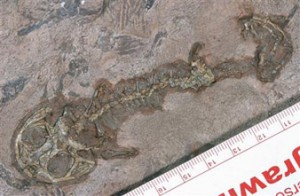Half Frog and Half Salamander helps shed light on modern Amphibian Ancestry
Attempts to understand the evolution of four-limbed vertebrates (i.e. tetrapods) has been dogged by the lack of fossil evidence to assist scientists in piecing together cladograms to show the relationships between the earliest land dwelling animals and their ancestors with more advanced forms of terrestrial creature.
Amphibian Ancestry
Even before we consider the evolutionary line of the amniotes (creatures that protect their embryos within a sealed structure – reptiles, mammals and birds, plus some early tetrapods), the evolution of Amphibia has been difficult to determine. Now the discovery of a “Frogmander” a fossil of an animal that shows both Anura (frog) and Caudata (salamanders and newts) characteristics may help resolve some of these issues.
Three Orders of Extant Amphibia
The modern class of Amphibia is made up of three orders. Firstly, there is the most diverse group around today the Anura consisting of the frogs and toads. Secondly, there are the salamanders and newts that belong to order Caudata. A third group, the Gymnophiona, contains the bizarre, segmented, leg-less caecilians. To help remember the three orders of amphibia, simply remember that those amphibians without tails are in the Anura order, whilst tailed amphibians are in the Caudata. Everything else, the caecilians are grouped into Gymnophiona.
The discovery and subsequent study of an ancient amphibian may help to resolve the ancestry of modern amphibians. An ancient “Frogmander” an animal that shows both frog-like and salamander-like characteristics may indicate that these modern amphibians shared a common ancestor.
An Artist’s Impression of Gerobatrachus

Picture credit: Reuters/Michael Skrepnick/University of Calgary
Gerobatrachus hottoni
The 290-million-year-old fossil was discovered in 1995, by a team of scientists from the Smithsonian Institute on an expedition to Texas. Canadian scientists led by Jason Anderson of the University of Calgary, Alberta, have been carefully removing the specimen from its matrix and making a close study of its morphological and anatomical features.
The fossil has been named Gerobatrachus hottoni or elderly frog, and the conclusions from the Canadian’s work have just been described in the scientific journal “Nature”.
“It’s a missing link that falls right between where the fossil record of the extinct form and the fossil record for the modern form begins,” commented Jason.
He went onto conclude that: “it’s a perfect little frogamander”.
Gerobatrachus has a mixture of frog and salamander features, with fused ankle bones as seen only in salamanders, a wide, frog-like skull, and a flexible backbone that resembles a mix of the two.
The Gerobatrachus Fossil
Picture credit: Reuters/University of Calgary
The picture shows the nearly complete fossil of Gerobatrachus, the large, wide, skull can be seen in the lower left of the picture.
The Evolution of Modern Amphibians
The fossil suggests that modern amphibians may have come from two groups, with frogs and salamanders related to an ancient amphibian known as a temnospondyl, and worm-like caecilians more closely related to the lepospondyls, another group of ancient amphibians.
“Frogs and salamanders share a common ancestor that is fairly removed from the origin of caecilians,” Anderson said.
Prior to this Canadian led study it had been thought that both frogs and salamanders may have been descended from the lepospondyls, but now this theory has been put forward that only the caecilians are descended from this group. This may have implications for the classification of Lissamphibians the collective name given to all three orders of modern amphibia
“The fossil itself is almost perfectly complete,” Anderson said.
“It died on its back. Its legs and arms were curled up on its belly and it’s that part that weathered away.”
Amphibians are represented very poorly in the fossil record. This is partly because they have relatively delicate skeletons and light bones. However, every now and then a truly amazing amphibian fossil is found, such as the partial remains of a huge frog, one that was capable of eating dinosaur hatch-lings.
To read more about this giant frog: The Frog from Hell, one that could jump continents







Leave A Comment